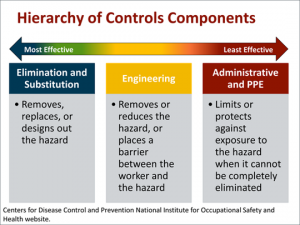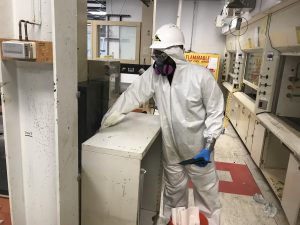In the environmental and general construction industries, breathing hazards are encountered on a common basis.
Some examples of respiratory hazards include:
- Vapors or particulates which are introduced into the air via intrusive work such as cutting or digging
- Chemical vapors off-gassing from improperly stored chemicals in a non-ventilated area
- Encountering a low-oxygen environment when entering a confined space to perform work
- Accumulation of gases in a building or room stemming from a gas pipe leak
In order to mitigate these hazards, the Occupational Health and Safety Administration (OSHA) has a hierarchy of approaches.
These are listed below from most desirable to least desirable:
- Elimination/substitution: remove the need for PPE by getting rid of the hazard.
- Engineering controls: use a process which inherently removes a hazard (e.g. particulate exhaust filters).
- Administrative controls: organize work in such a way that workers can avoid the hazard.
- Personal protective equipment (PPE): use of protective equipment by individual workers.
For site work where respiratory hazards exist and cannot be eliminated or properly mitigated by engineering or administrative controls, we must choose the proper PPE to mitigate said hazards. First, the safety engineer or superintendent must identify the hazards, both with respect to particulate and chemicals, if possible.
There are four different categories of PPE, level A, B, and C which require a level of respirator use, and level D which does not. Previous knowledge of a site will impact which type of respirator should be used.
Level A, B, and C all require chemical-resistant coveralls, gloves, and steel toed boots, however have separate, distinct requirements:
- Level C is the least restrictive and involves wearing a full- or half-face respirator which contain specialized filters based on expected hazards. These are known as air-purifying respirators.
- Level B is more restrictive and requires the use of a full-face positive-pressure respirator, which means that air is moving from a higher pressure inside the facepiece to a lower pressure in a potentially hazardous environment. This is commonly achieved using a clean, supplied air source. Level B PPE is the “go-to” when entering an environment not previously sampled or explored.
- Level A is identical to level B respirator-wise, but requires more robust chemical-resistant clothing due to skin exposure hazards.
If you must wear a tight-fitting respirator, fit testing is required by OSHA to be performed once every twelve months to ensure worker safety. Fit testing can either be done by your current employer or an outside party.
Walden has a team of safety professionals or engineers with experience in respiratory hazard identification and mitigation procedures. If you have a job coming up that may require respirator use or if you are wondering if this information pertains to your industry, please give us a call today at (516) 624-7200.


